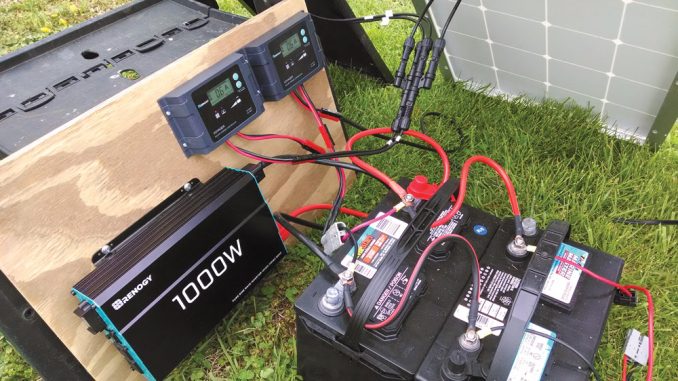
The Right Inverter To Power Key Electric Devices
Keeping the lights on and appliances functioning during power outages has long been the job of gasoline-powered portable generators. However, solar-powered generators are becoming more efficient and popular and are proving to be just as capable in most instances while offering several advantages.
A few of these are:
- No hazardous fuel to store or spill
- Almost zero maintenance
- Silent power generation
- Always ready to supply electricity when needed
- Expandable as needed or as the budget allows
Inverters
A solar-powered generator uses solar panels to convert sunlight into electrical energy, which is then regulated by a charge controller and stored in batteries for later use. This low-voltage, direct-current (DC) energy must be converted into alternating current (AC) at a much higher voltage to power items designed to use utility power. This is accomplished with a DC-to-AC battery power inverter.


Two 100 Ah deep-cycle batteries, along with 260 watts of solar input, ran the author’s air conditioner for two hours straight before the batteries discharged to 50 percent. Taking them any lower could shorten their lifespan.
Not all inverters are suitable for running home appliances or sensitive electronics. Inverters typically sold at auto parts or big-box discount stores are what are known as “modified” sine wave inverters, which produce a stair-step AC waveform that roughly mimics what comes from your home’s electrical outlets. This might be good enough for charging a cellphone or laptop computer, but it might not satisfy the power requirements of other devices commonly used in the home.
Appliances that use electric motors to operate fans or compressors need clean AC power, and this requires something better: “Pure” sine wave inverters produce a clean, alternating sinusoidal waveform that’s more like that from your power company.

The Renogy 1,000W Pure Sine Wave Power Inverter is a high-quality solar accessory that’s perfect for off-grid systems.
Pure sine wave inverters are more sophisticated and a bit more expensive. In addition, they’re often hard to find at local retailers. Having ordered several from online sources over the years, I’ve found most to be disappointing in terms of features or quality. Nevertheless, there are some that are exceptional, such as those from Renogy.
Renogy’s Pure Sine Wave Inverter
Available in output ratings from 700 to 3,000 watts, Renogy Pure Sine Wave Inverters produce a sinusoidal waveform to power even the most sensitive electric appliance or device. In this product review, we’ll take a look at the Renogy 1,000W model.
The Renogy 1,000W is loaded with features you’d expect from a high-quality inverter. And, with a retail price that’s less than $200, it’s an outstanding deal. Some of its features include:
- Overload protection for both DC input and AC output to prevent damage to the components and the unit
- Offers a high-quality waveform with little harmonic distortion (under 3 percent)
- LED indicators for under-voltage and over-voltage protection, over-temperature protection, overload protection and short-circuit indication
- Ground-fault circuit interrupter (GFCI) protection
- Thermally controlled, high-speed ventilation fans to help keep the inverter running at a low temperature
- Built-in 5V/2.1A USB port for charging portable devices
- AC hardwire port for direct-connecting high-current appliances
- Quiet operation with no static or humming noise
- Wired remote control and heavy-duty 4 AWG (American wire gauge) input cables included
The Renogy inverter included everything I needed to connect it to my existing 12-volt, deep-cycle battery bank. I followed the instructions in the well-written manual, so it was a simple task. And, once powered on, testing began.

These are the components and basic connections of a solar generator setup.
Testing, Testing
Because my intended use for this inverter is to power essential household appliances, that’s exactly what I did.
Refrigerator: Extended power outages during warm months can lead to spoiled food, so the kitchen refrigerator/freezer was my top priority. Our full-sized fridge is 5 years old and likely represents what most people have in their home. Powered by the Renogy 1,000W Pure Sine Wave Inverter, the appliance operated the same as it does on utility power. The energy consumption was identical—right at 100 watts while running. After a full 24 hours, the refrigerator had consumed 1.4 kilowatt hours of electricity, and the inverter never skipped a beat. Refrigerators don’t run constantly, so this wasn’t much of a strain on the inverter or on my small, solar-powered generator system.
Then, it was time to move up a notch.

Dual thermostatically controlled fans keep the inverter cool, and the shrouds over the 12-volt connection terminals ensure safety.
Air conditioner: Many people consider air conditioning a luxury, but for some, it’s essential. It might not be necessary to run the central air conditioning during power outages, but a portable room air conditioner could come in handy.
An 8,000 BTU model was a good appliance for testing the Renogy inverter under more-strenuous conditions.
On startup, the air conditioner draws more than 10 amps at 115 VAC (approximately 1,200 watts), before settling down to around 700 watts while cooling the room.
The inverter handled the startup surge without issue and, after a few minutes of operation, the internal fans came on. Although noticeable, the sound of the fans wasn’t loud. This test was halted when the remaining charge in the pair of 12V, 100 amp hour, deep-cycle batteries reached 50 percent. With the air conditioner drawing more than 60 amps from the batteries and solar panels, this only took a couple of hours. However, the inverter was only warm to the touch at the end of the two-hour run.

Modified sine wave inverters produce a stairstep alternating current that’s not suitable for many appliances. (Created by Omegatron/ Wikipedia image)
Fan: If a fan is all you need to keep cool, the Renogy Pure Sine Wave Inverter isn’t overkill. In fact, it was an ordinary, 20-inch box fan that made me realize I needed a pure sine wave inverter to begin with.
While working in an enclosed area that was well away from utility power, I attempted to run a box fan off the modified sine wave inverter I keep in my truck. The fan complained (with a loud humming sound) and seemed to struggle coming up to speed.
Once back at the house, I tried running it off a larger, more capable inverter (also a modified sine wave model) and had the same result.

This example of a sinusoidal waveform, like that from your power company, is what most electrical appliances and devices are designed to use. (Created by Omegatron/ Wikipedia image)
Nevertheless, plugging the fan into utility power, the fan operated quietly and normally (the problem had been the rough AC produced by the cheaper inverters). I ran that same box fan on the Renogy Pure Sine Wave Inverter for days on end, and it operated perfectly.
Without question, the Renogy 1,000W was capable of running all the appliances tested, along with a few LED lamps and, amazingly, all at the same time! The only limit was the capacity of the batteries and solar panels I had on hand.
The Bottom Line
If you want to power household appliances and devices when or where grid power is not available, Renogy Pure Sine Wave inverters make this both possible and practical. Properly sized to the load, they can provide utility-grade power to appliances and devices that require a clean, smooth and stable AC source. As long as there’s sufficient battery capacity and adequate solar input, this can be done indefinitely.
(Author’s note: For this review, a series of real-world tests were carried out over a three-month period. No specialized test equipment was used. The results are based purely on observation, voltage measurements and data from a commercially available P3 Kill A Watt test meter. Your results might differ.)

The author’s solar generator setup for the refrigerator test. An extension cord ran from the Renogy 1,000-watt inverter to the kitchen

The included wired remote permits control of the inverter, even when it’s installed in hard-to-reach places.

Here, the Renogy 1,000W Pure Sine Wave Inverter is mounted on a plywood board, along with a pair of Renogy Voyager 12-volt, 20-amp charge controllers that are the core components of the author’s solar power generator. These will eventually be installed in an underground storm shelter.

Installing solar panels is the beginning of the process of turning sunlight into electricity.

The 12-volt input connection must be tight and secure. Renogy makes that easy to accomplish.

The included four AWG cables are capable of delivering full input power from the batteries up to the inverter’s rated output power of 1,000 watts continuously. One thousand watts at 115 volts equates to an electrical current of about 8.7 amperes from the AC output. However, the DC input is much higher, at around 90 amps.

An 8,000 BTU portable air conditioner that was set up inside a tent for testing on a hot day provided a good test of the Renogy 1,000W.
Editor’s note: A version of this article first appeared in the September, 2020 print issue of American Survival Guide.
The post Renogy’s 1,000-Watt DC/AC Solution appeared first on American Survival Guide.






Be the first to comment